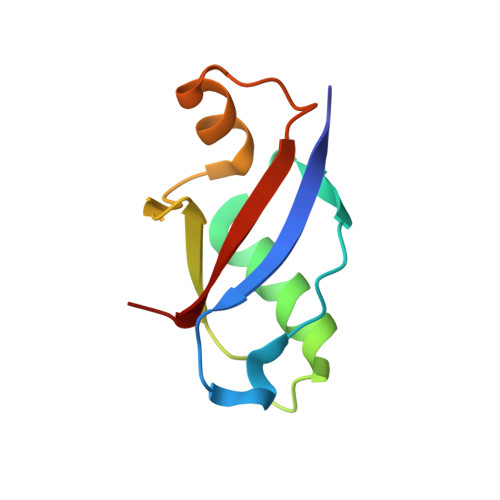The Crystal Structure of the Ubiquitin-like Domain of Ribosome Assembly Factor Ytm1 and Characterization of Its Interaction with the AAA-ATPase Midasin.
Romes, E.M., Sobhany, M., Stanley, R.E.(2016) J Biol Chem 291: 882-893
- PubMed: 26601951
- DOI: https://doi.org/10.1074/jbc.M115.693259
- Primary Citation of Related Structures:
5DTC - PubMed Abstract:
The synthesis of eukaryotic ribosomes is a complex, energetically demanding process requiring the aid of numerous non-ribosomal factors, such as the PeBoW complex. The mammalian PeBoW complex, composed of Pes1, Bop1, and WDR12, is essential for the processing of the 32S preribosomal RNA. Previous work in Saccharomyces cerevisiae has shown that release of the homologous proteins in this complex (Nop7, Erb1, and Ytm1, respectively) from preribosomal particles requires Rea1 (midasin or MDN1 in humans), a large dynein-like protein. Midasin contains a C-terminal metal ion-dependent adhesion site (MIDAS) domain that interacts with the N-terminal ubiquitin-like (UBL) domain of Ytm1/WDR12 as well as the UBL domain of Rsa4/Nle1 in a later step in the ribosome maturation pathway. Here we present the crystal structure of the UBL domain of the WDR12 homologue from S. cerevisiae at 1.7 Å resolution and demonstrate that human midasin binds to WDR12 as well as Nle1 through their respective UBL domains. Midasin contains a well conserved extension region upstream of the MIDAS domain required for binding WDR12 and Nle1, and the interaction is dependent upon metal ion coordination because removal of the metal or mutation of residues that coordinate the metal ion diminishes the interaction. Mammalian WDR12 displays prominent nucleolar localization that is dependent upon active ribosomal RNA transcription. Based upon these results, we propose that release of the PeBoW complex and subsequent release of Nle1 by midasin is a well conserved step in the ribosome maturation pathway in both yeast and mammalian cells.
Organizational Affiliation:
From the Signal Transduction Laboratory, NIEHS, National Institutes of Health, Department of Health and Human Services, Research Triangle Park, North Carolina 27709.














